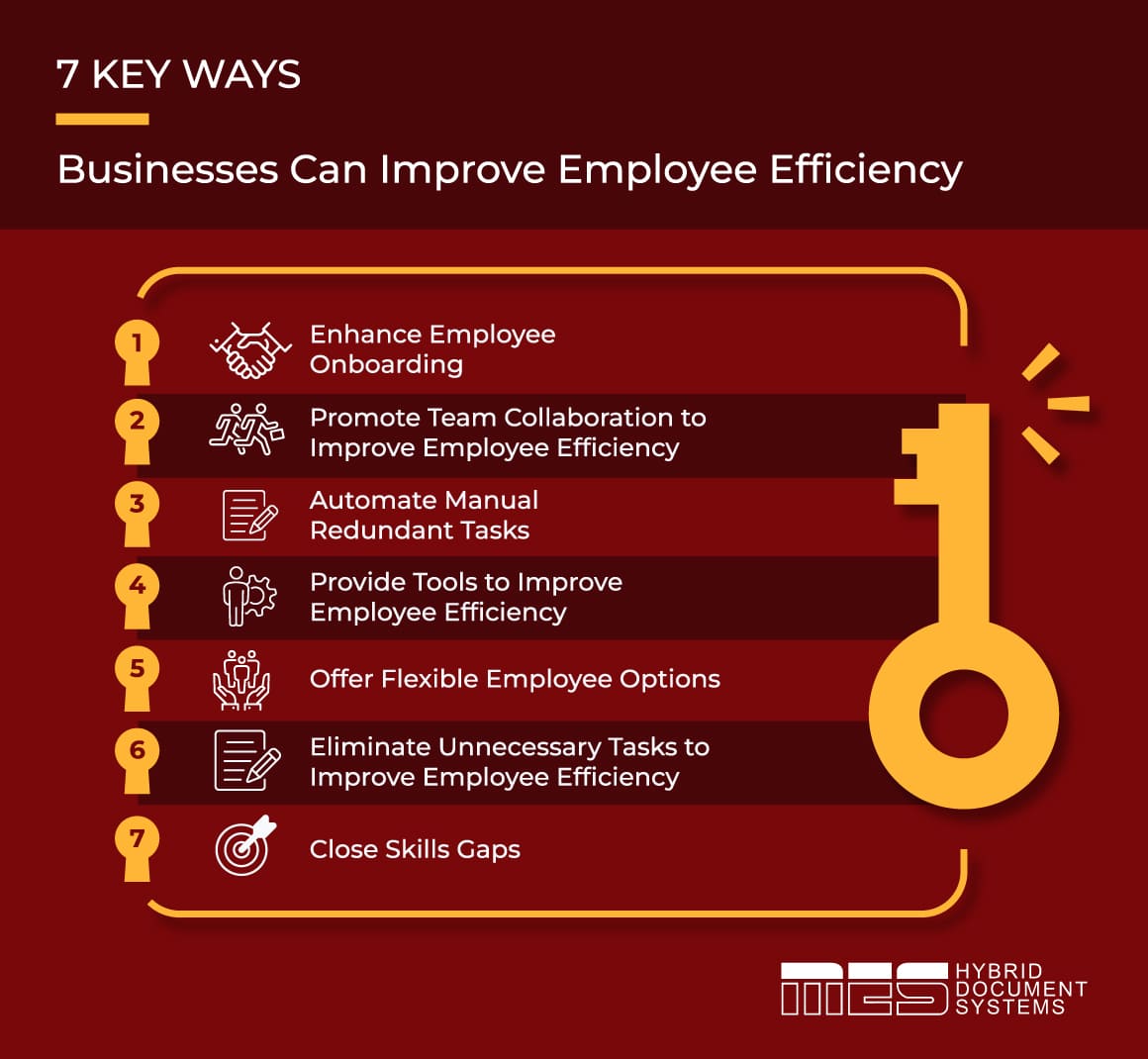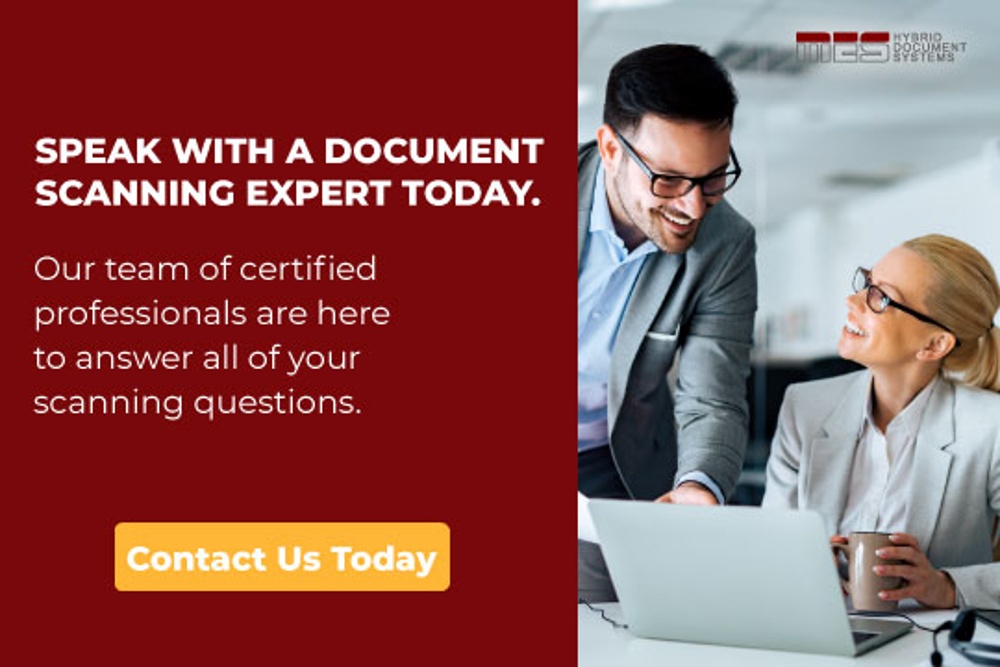Employee and work efficiency impacts profit margins. The longer it takes to complete each task, the more it eats into your bottom line. As a result, you should always be looking for ways to improve employee efficiency for increased productivity. Here we look at seven key ways businesses can improve employee efficiency by decreasing low-value tasks.
1. Enhance Employee Onboarding
Efficient employees begin with efficient and effective onboarding. Onboarding is a critical step to get new hires into the swing of things as quickly as possible. However, when not done properly, you can end up costing hundreds of hours in training or, worse, rehiring because new employees are not primed for success. Employee onboarding calls for efficiencies in the Human resources department that include:
- Self-guided solutions that allow new hires to complete required paperwork without the need for HR administrative assistance
- Easy-to-access documents that allow new hires to learn more about your organization to fit in with your company culture
- Less involvement from management and existing employees and more focus on self-guided training
- Onboarding document management systems that provide all the information needed to increase employee success
- An improved welcoming process that increases talent retention and strengthens your workforce
An effective HR document management system manages the common paperwork and processes that create inefficiencies in the onboarding process. From payroll setup to accurate employee database records and accessing information such as benefits administration to training manuals, an effective document management system streamlines the onboarding process. It also creates secure, up-to-date employee databases that are easier to maintain throughout an employee’s career life cycle with your company.
2. Promote Team Collaboration to Improve Employee Efficiency
When departments work in silos, or you have employees who work from home, business processes are hampered. When you improve employee or team collaboration, you empower each team to become involved in the right steps to avoid common things that slow people down.
A perfect example of collaboration is document sharing. In accounts payable, there are often several touchpoints where approvals are required. Trying to reconcile orders with POs, packing slips, and final arrival to their intended destination is a time-consuming process. However, with a document management system that allows people to easily collaborate on documents without the risk of ruining the integrity of the records, processes are streamlined, errors are avoided, and documents never get lost in the shuffle.
In manufacturing, when departments are too “self-contained,” it becomes difficult to locate data across multiple systems and departments. You’re also often juggling many different document formats with so many players involved, from research and design to marketing and from the manufacturing foremen to the quality control team.
If you’re depending on slow paper-based processes, all the documents that must be shared, reviewed, and approved take far too much time. It also makes it difficult to keep track of what documents are sitting on whose desk which can lead to the loss of valuable paperwork critical to your success. Improved workflows using up-to-date data management systems and digitizing paper and large-format blueprints make it easier to quickly share documents when they are needed without the risk of accidental changes to the information.
3. Automate Manual Redundant Tasks
Even in the digital age, many companies are still bogged down by manual redundant tasks that take a longer amount of time to complete. A process that should be simple such as searching and finding documents from anywhere can go from 45 minutes to locate a stored paper document to seconds to search, find and share a digital document from cloud storage. Automation reduces document loss and the risk of human errors. Automation tools such as document management software reduce the steps required to access documents while eliminating the possibility of common document-related challenges such as:
- Loss
- Damage
- Unauthorized sharing
- Making several copies to share with multiple departments
- Documents being taken offsite exposing proprietary information
- Unauthorized edits and alterations
Automation tools improve employee productivity and allow sequential, repetitive tasks to occur automatically so critical steps are never missed. Authorizations and approvals are made as part of the automated process, so each step progresses without delay.
4. Provide Tools to Improve Employee Efficiency
Tying in with the above, the right tools empower employees to perform their jobs efficiently. A failure to invest in technology that creates productive workplaces ends up costing you more in the long run. Tools today that make a major positive impact on efficiencies include:
- Chat software to answer questions quickly so people can continue working
- Database software that allows people to access information anywhere, at any time, with role-based protocols for security
- Task management software to create a more collaborative working environment, so everyone understands their deliverables and deadlines
These are just a few examples of the types of basic tools that improve performance and change the focus to higher-value tasks.
5. Offer Flexible Employee Options
Flexibility, such as remote work and flexible work hours, can also improve efficiencies as it helps employees feel they have more control over their work/life balance. With easy access to cloud-stored documents, employees can work from home with fewer distractions and zero travel time which makes people late.
When employees set their own hours, they tend to be happier and more engaged, which means the quality of their work improves. You get more out of each employee, and there are fewer workflow interruptions. Staff are 100% focused on the tasks at hand without common office distractions such as meetings, co-worker chat, and time-wasting micromanagers.
6. Eliminate Unnecessary Tasks to Improve Employee Efficiency
Identify unnecessary tasks that waste time. Do you really need a daily meeting? Are you still using paper time sheets that HR has to enter into your system? Do you have an offsite document storage space employees have to visit? Are there too many formalities meant to improve processes that are interfering with productivity? Is customer service bogged down with service calls because your website doesn’t offer an easy FAQ section? Consider each department and how their tasks either improve efficiencies or take away from efficiencies. Then eliminate unnecessary tasks so everyone can accomplish their goals.
7. Close Skills Gaps
Employee skills gaps completely break down efficiencies. Whether it is knowledge-based, technical skills or a gap in the level of performance, identifying skills gaps allows you to take the necessary steps to close them.
Knowledge Gaps
When employees can’t access the information they need to conduct their work, their productivity decreases. If you empower employees with access to documents, through collaboration, document sharing, and basic updates about the business, they are equipped to perform their jobs more efficiently.
Skills Gaps
Skills gaps often occur when you make company changes but don’t assess a person’s capabilities to keep up with those changes. Common scenarios include introducing new software before you train and develop the employee or taking on new responsibilities because you have downsized your workforce.
Ensuring each person has the appropriate skills to perform their jobs based on changes you make helps eliminate weaknesses that reduce employee productivity. This also includes soft skills. For example, having someone who always worked behind the scenes handle customer service is bound to fail.
Performance Gaps
Ongoing performance reviews and employee feedback identifies performance gaps. It ensures employees understand their strengths and weaknesses, what they are expected to achieve, and how they are expected to achieve it. Employees who understand their roles and company expectations either rise to the occasion, fail or seek a more suitable position elsewhere. When you improve communication, you can help workers reach their optimized performance levels across the board.
How is Workplace Efficiency Measured?
There are a few ways you can measure workplace efficiency:
- Labor time to goods produced: In manufacturing settings, it is simplified because you can compare apples to apples. How much was produced, and how long did it take to produce it? This ratio is ideal for efficiency in the factory setting and can be set with quotas to ensure everyone understands what they are expected to do each day. This also sets benchmarks for you to measure against, making it easier to monitor employees’ performance.
- Employee progress: In this case, you see how well an employee progresses in their performance level. This might be based on skills they are expected to achieve during training, can involve milestones set during onboarding, or can be goal oriented with tasks and deadlines. Keeping an eye on workflows and ensuring each team member is completing their work tells you how productive they are in meeting company or department goals.
- Customer satisfaction: In hospitality, retail, or any customer/patient-facing position, efficiency is measured on customer feedback. By sending out questionnaires following order fulfillment or the completion of services provided, you can measure performance based on customer satisfaction levels. Courtesy, ability to resolve issues, attitude, employee engagement, etc., are all measures of customer experience. You can also monitor performance based on observation.
Finding employee efficiency opportunities should be an ongoing effort that allows you to improve constantly. These tips look at the key areas to focus on so you can reach optimum performance levels.
At MES, we offer document scanning services and management solutions that make it easier to run your business. Reach out to us today to discuss the document management systems available to improve efficiencies.



